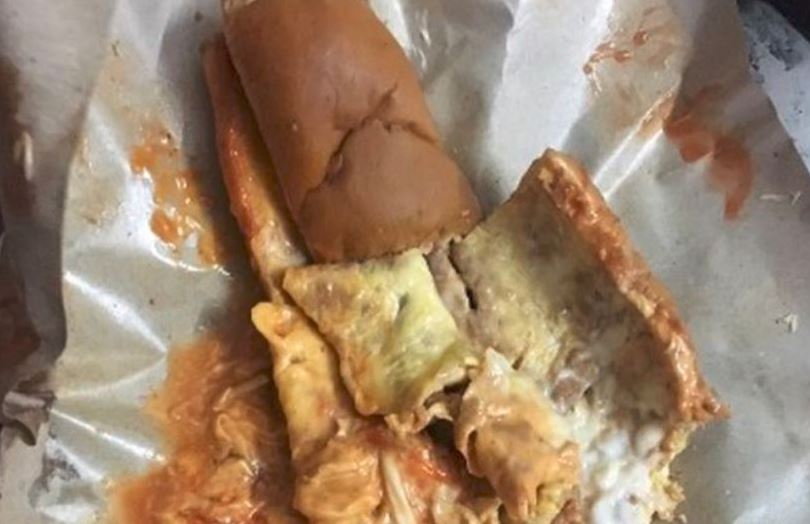The hilarious history behind how Malay hawkers gave roti John its name

- 1.5KShares
- Facebook1.3K
- Twitter7
- LinkedIn5
- Email15
- WhatsApp54
[This article was originally written in BM. Click here to read.]
If you enjoyed this story and want more like this, please subscribe to our HARI INI DALAM SEJARAH Facebook group ?
Now that Ramadhan is over, some of us would be missing the treasures of the Ramadhan bazaars. Yum. But amongst the great food and fun, there are also some bad apples (or bad kuihs). Like the “oxygen currypuff“, which is basically a currypuff without filling. Now, we’re hearing about how upset peeps are about the way Roti John has been served lately, alongside the rising prices.
“Roti John is a scam. It’s just a bun mixed with egg, really thin pieces of meat, add some vegetables, tonnes of sauce and mayonnaise, add the word ‘leleh’ (drool), RM7…” – a tweet by @pittssuda, ranting about the unreasonable pricing of a roti John lacking the meat component.

But while people are ranting about overcharged-yet-bad roti Johns, we wondered how a bread in our country ended up having a Westernised name. So, we dug a little into the history of roti John and were drooling found out that…
(Warning: CILISOS will not be liable for any cravings triggered by the content in this article. And no roti Johns were harmed in the making of this article.)
Roti John got its name because some people may have misheard
As we know it, a typical roti John consists of sliced halves of a French loaf fried with chopped onions, minced mutton and egg. Variations of this delicacy replace mutton with chicken, beef or sardine and include additions of cheese and mushrooms etc (there is even a vegan recipe for it, but not widely available in shops lah). The current prices range between RM4.50 and RM7.00.

According to a report by Straits Time Singapore in 1988, around the 1960s, an Englishman ordered a hamburger at a Malay food stall in Sembawang, Singapore. But hamburgers were rare in Malay food stalls back then.
So, the vendor got a little creative and spread some minced meat and chopped onions between slices of French loaf and fried the whole thing with egg. The Straits Times has a theory that Malays back then addressed Englishmen as John, so in this case, the vendor said while serving,
“Silakan makan roti, John.” (“Please eat this bread, John”)
The people around there probably overheard it as “Silakan makan roti John” (like “Please eat this John bread”), so the name stuck like that till now.

The roti John, which was typically sold by Indians in areas frequented by British soldiers in Singapore, went through some modifications. A 1973 Berita Harian article credited the localisation of roti John to Zawiah Anwar of Geylang Serai Food Centre, who prepared the roti John using mutton, eggs, onions, peas and tomatoes.
It later gained popularity when Shukor and his wife Khadijah bt Mohd Salleh opened a stall in Taman Serasi (still Singapore) in 1976. They learnt the recipe from a Geylang hawker, and slowly modified the recipe by replacing peas and tomatoes with SAMBAL, which later became a benchmark for roti Johns. It was so popular that they sold about 800 pieces on weekends and 100 plates daily.

Even the cooking style was different compared to the rest. While some cook an omelette separately and put it on the French loaves, it’s common for hawkers to cook the omelette on the griddle and invert the loaves on top of the cooking eggs. This couple’s roti John though…
“Cik Khadijah’s method appears to defy the law of gravity. She beats up to 30 eggs at a go, adds chopped onions, minced mutton and sambal to the eggs, then pours some of the mixture on open halves of French loaves. She then inverts the dripping bread on to a griddle without spilling much of the filling.” – quoted from the Straits Times, 2nd Nov 1986.
Later on, the roti John made its way into more hungry tummies in the Malay Peninsula (Malaysia and Indonesia), which is probably why…
Some peeps are trying to salvage the roti John (and probably street food business in general)
As we mentioned earlier, people have been upset with the quality of the roti Johns being sold at the Ramadhan bazaars lately. Like this guy:
“Now when I order a ‘Roti John’, I pay attention to how they make it, if it is just a bun mixed with egg and some sauce on it, I’ll cancel the order.” – a tweet by @ajibtoo.
Such attempts to skimp on ingredients can be counterproductive for those trying to make a quick buck that way. An unnamed roti John seller (who earns a monthly profit of roughly RM10,000) shared with Buku Resepi that the main reason some street food businesses fail is the vendors’ lackadaisical attitude (choose to sell street food as a last resort, think got no future in selling street food, close shop when lazy to work, sell the easiest food to cook, etc).
“Many of the vendors can’t wait to get rich quick.” – RM10k profit roti John seller told Buku Resepi.
But as another Twitter user @pittssuda (the same guy we quoted at the start) pointed out, not all vendors are greedy and stingy like this and that there are still some good ones around.

In fact, some businesses would go the distance to serve the best roti John in town, literally. One of them was Kelantan-based Western cuisine restaurateur Hazuwi Yaacob, who has been travelling between Kelantan and Jakarta since 2015 to learn from the best.
” I choose roti John because this dish is popular at pasar malams and Ramadhan bazaars but I wanted to make roti John that doesn’t just taste like an egg sandwich. So when I looked up on the internet for a place that serves yummy roti Johns, Jakarta caught my eye because many are selling it by the road side.” – Hazuwi Yaacob told Berita Harian.

Besides Hazuwi, other people have proven that prioritising customers’ best interests is much better than trying to make a quick buck from skimping on ingredients.
OhBulan described a success story of an unemployed engineering grad who got into the roti John business while waiting for interview callbacks. He went from a daily sale of just 3 pieces to 70 pieces by changing his business strategies accordingly, including high quality ingredients, reasonable pricing, great service and ensuring that the roti John he serves meets the customers’ needs.
This seems synonymous with the Netflix docu-series titled Street Food, which shows that the street food vendor who serves the highest quality street food would attract more customers, more respect and hence more sales.

Bernama writer Erda Khursyiah Basir, who wrote about how stinginess has become common in street food businesses these days and can adversely affect these same businesses, had this to say in her article:
“Sellers need to be smart in planning their business strategy so as not to be seen as so obsessed with making profits that they neglect consumer rights. If the food is delicious and reasonably-priced, there will be repeat customers.
Sellers must be wary of the power of social media today as how they treat their customers can influence their profits and losses.” – Erda wrote on Bernama.
If you enjoyed this story and want more like this, please subscribe to our HARI INI DALAM SEJARAH Facebook group ?
- 1.5KShares
- Facebook1.3K
- Twitter7
- LinkedIn5
- Email15
- WhatsApp54
